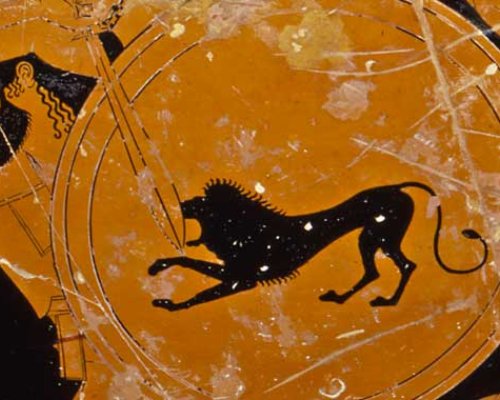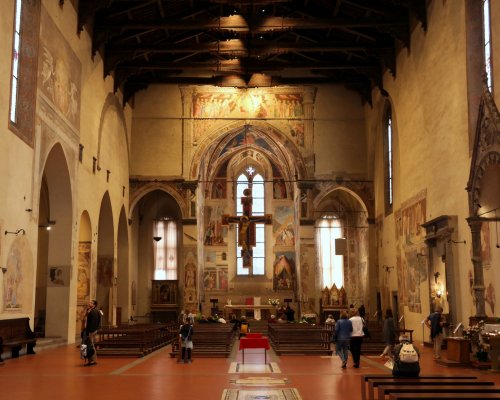From museums to archeological areas
The Arezzo area is home to numerous artefacts connected to the mysterious and fascinating Etruscan civilization. The city of Arezzo conserves some of these artefacts in its extraordinary “Gaio Cilnio Mecenate” Archeological Museum, located inside the former Olivetan Monastery of S. Bernardo, built atop the ruins of a Roman amphitheatre dating to the early 2nd century CE.
The numerous objects on display at the Archeological Museum attest to the importance of the city and the territory of Arezzo in the Etruscan era. These include the red-figure Attic Krater of Euphronios (500 BCE) and the amphora by the painter Meidias, a collection of jewellery coming from the burial sites in the area, specifically the Poggio del Sole necropolis south-east of the city, a polychrome decorative slab from a temple discovered in the city, near piazza S. Jacopo, and clay busts and portraits of male and female figures, even children, coming from the Castelsecco sanctuary near Arezzo.
The numerous objects on display at the Archeological Museum attest to the importance of the city and the territory of Arezzo in the Etruscan era. These include the red-figure Attic Krater of Euphronios (500 BCE) and the amphora by the painter Meidias, a collection of jewellery coming from the burial sites in the area, specifically the Poggio del Sole necropolis south-east of the city, a polychrome decorative slab from a temple discovered in the city, near piazza S. Jacopo, and clay busts and portraits of male and female figures, even children, coming from the Castelsecco sanctuary near Arezzo.
From the Archeological Museum, walking towards the city centre, is piazza S. Francesco, with its church famous for the fresco cycle painted by Piero della Francesca, depicting the Legend of the True Cross. Below the piazza, there are traces of buildings dating to several periods, beginning in the 6th century BCE. Piazzetta S. Niccolò sits at the top of the hill, where recent digs have revealed the ruins of an Etruscan-era wall that surrounded the city as well as a place of worship used in the 4th century BCE.
From the Archeological Museum, walking towards the city centre, is piazza S. Francesco, with its church famous for the fresco cycle painted by Piero della Francesca, depicting the Legend of the True Cross. Below the piazza, there are traces of buildings dating to several periods, beginning in the 6th century BCE. Piazzetta S. Niccolò sits at the top of the hill, where recent digs have revealed the ruins of an Etruscan-era wall that surrounded the city as well as a place of worship used in the 4th century BCE.
Close by, between the hills of San Pietro and San Donato, where the cathedral and Medici Fortress are today, there as once the Etruscan city. In viale B. Buozzi, the road leading running along the length of the fortress, there are ruins of a temple dating to around the 2nd century BCE.
Close by, between the hills of San Pietro and San Donato, where the cathedral and Medici Fortress are today, there as once the Etruscan city. In viale B. Buozzi, the road leading running along the length of the fortress, there are ruins of a temple dating to around the 2nd century BCE.
The history of the Etruscans in Arezzo ends a few kilometres north-east of the historic centre, in S. Cornelio-Castelsecco. On the hill, there are still ruins of a theatre-temple used mostly in the 2nd century BCE but whose origins date even further back. The building is located on a high plain that dominated over the Arezzo landscape to the east, known as the Valtiberina. The discovery of terracotta objects depicting children wrapped in cloths, today on display at the Archeological Museum, have led scholars to believe that building was also a place of worship dedicated a divinity that was a protector of motherhood.
The history of the Etruscans in Arezzo ends a few kilometres north-east of the historic centre, in S. Cornelio-Castelsecco. On the hill, there are still ruins of a theatre-temple used mostly in the 2nd century BCE but whose origins date even further back. The building is located on a high plain that dominated over the Arezzo landscape to the east, known as the Valtiberina. The discovery of terracotta objects depicting children wrapped in cloths, today on display at the Archeological Museum, have led scholars to believe that building was also a place of worship dedicated a divinity that was a protector of motherhood.
Leaving Arezzo behind, head down regional road 71 until Pieve a Socana, in the municipality of Castel Focognano, in the Casentino, a few kilometres from the right bank of the Arno. In the apse of the Romanesque Parish Church of S. Antonino, there is a large Etruscan altar that was primarily used from the 5th to 1st century BCE. The site is located at the crossroads between two probable routes towards the Casentino, one coming from Arezzo and another from the Lower Valdarno.
Archeological digs carried out a few decades ago brought to light a staircase that would have once led to the temple that was oriented in the opposite direction of the church. The site is a clear testament to Etruscan faith, which was closely tied to other places of worship in the valley, like the one on Monte Falterona and its votive offerings, deep in the Casentino.
Leaving Arezzo behind, head down regional road 71 until Pieve a Socana, in the municipality of Castel Focognano, in the Casentino, a few kilometres from the right bank of the Arno. In the apse of the Romanesque Parish Church of S. Antonino, there is a large Etruscan altar that was primarily used from the 5th to 1st century BCE. The site is located at the crossroads between two probable routes towards the Casentino, one coming from Arezzo and another from the Lower Valdarno.
Archeological digs carried out a few decades ago brought to light a staircase that would have once led to the temple that was oriented in the opposite direction of the church. The site is a clear testament to Etruscan faith, which was closely tied to other places of worship in the valley, like the one on Monte Falterona and its votive offerings, deep in the Casentino.


